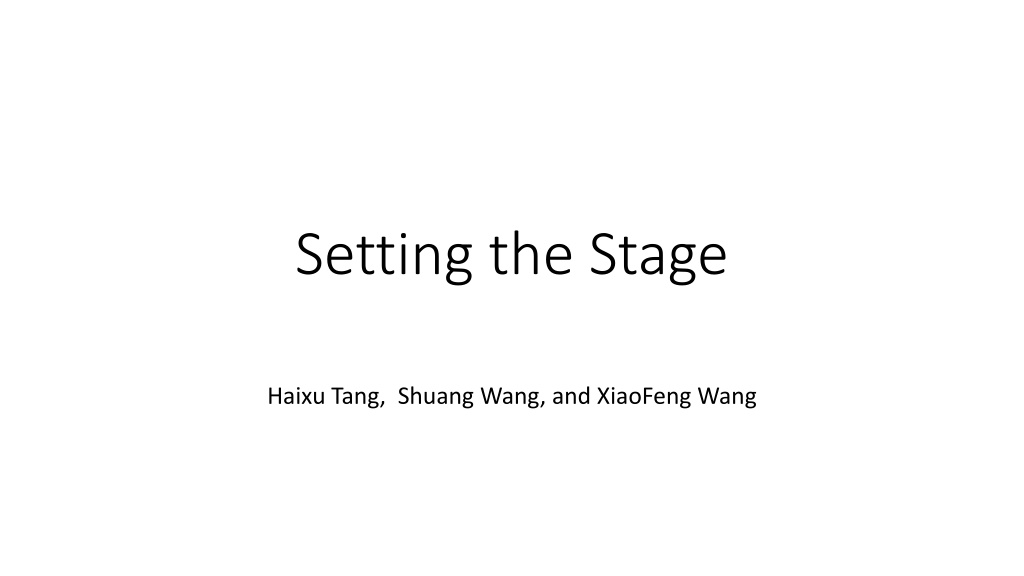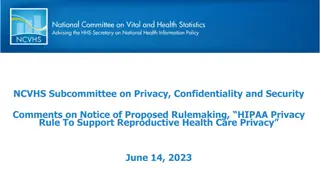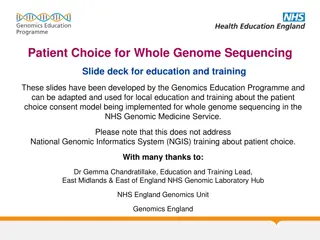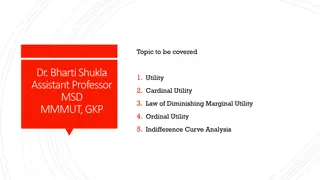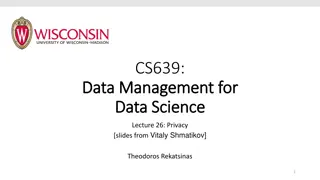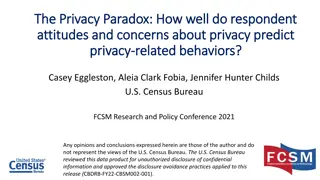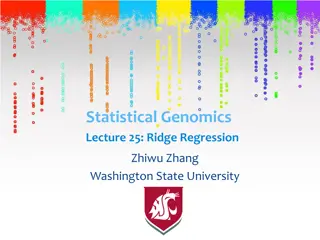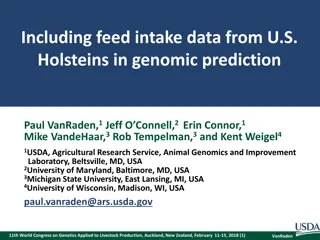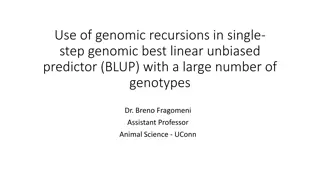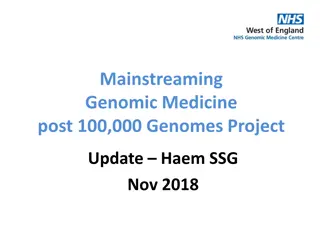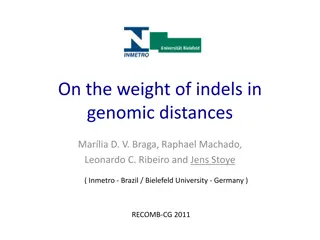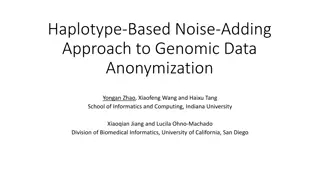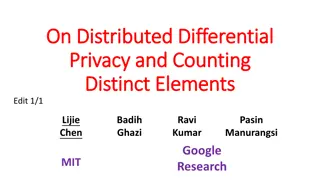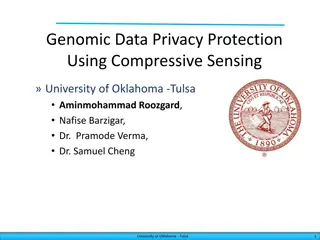Genomic Data Privacy and Utility Analysis
Balance between privacy and utility in publicly released SNP data for GWAS, focusing on re-identification risks and identification of significant SNPs. The study involves datasets from the Personal Genome Project and HapMap Project, with emphasis on privacy protection techniques and association tests.
Download Presentation

Please find below an Image/Link to download the presentation.
The content on the website is provided AS IS for your information and personal use only. It may not be sold, licensed, or shared on other websites without obtaining consent from the author.If you encounter any issues during the download, it is possible that the publisher has removed the file from their server.
You are allowed to download the files provided on this website for personal or commercial use, subject to the condition that they are used lawfully. All files are the property of their respective owners.
The content on the website is provided AS IS for your information and personal use only. It may not be sold, licensed, or shared on other websites without obtaining consent from the author.
E N D
Presentation Transcript
Setting the Stage Haixu Tang, Shuang Wang, and XiaoFeng Wang
Outline Data and Methodology Participants and Results Discussion
Data Selection Data source 411 Cases from Personal Genome Project (PGP:http://www.personalgenomes.org/) 174 Controls from CEU population of International HapMap Project (http://hapmap.ncbi.nlm.nih.gov/) Summary of case (PGP) data Before preprocess Participants 411 Total SNPs 29757319
Data Preparation Preprocess of PGP data SNP sites supported by HapMap Genotypes supported by HapMap Genotypes supported by at least 174 participants Participants supporting at least 90,000 valid genotypes Missing values filled by using fastPHASE Summary of case (PGP) data After preprocess Participants 201 Total SNPs 106129
Data preparation Task 1: data publishing Case: 200 PGP individuals Control: 174 CEU individuals Data set 1: 311 SNVs Data set 2: 600 SNVs Filtered and genotyped Task 2: top-K SNP identification Case: 201 PGP individuals Control: 174 CEU individuals Data set 1: 5000 SNVs Data set 2: 106,129 SNVs Overview and methodology papers are under review for BMC Biomedical Informatics and Decision Making 6 3/2/2025
Task 1: Privacy Preserved Data Sharing Two genomic loci with consecutive SNPs with Different levels of significance under case-control association tests High re-identification risk before applying privacy- preserving technologies Datasets: Dataset 1 200 participants, 311 SNPs (~29504091-30044866, chr2) Dataset 2 200 participants, 610 SNPs (~55127312-56292137, chr10)
Challenge of Task 1 Goal: Understand the privacy-utility balance achievable when publicly released SNP data, after proper anonymization, for a realistic GWAS Utility: the number of significant SNPs identified by the Chi-square association test over the case population (200 individuals from PGP) and a control population (from HapMap) Privacy Protection: the anonymized data s resistance to one of the strongest re-identification statistical attack (i.e. the likelihood ratio test).
Privacy: Evaluation of Privacy Risks using Likelihood Ratio Test Implemented as an online tool that allows challenge participants to examine privacy risks in their noise-added data: http://humangenomeprivacy.org Sankararaman, S., Obozinski, G., Jordan, M. I., & Halperin, E. (2009). Nature Genetics, 41(9), 965 7. doi:10.1038/ng.436
Utility: Case-Control Association Test Chi-square: , where, r is number of rows , c is number of columns, Oi,j is observed frequencies, Ei,j is expected frequencies
Task 2: Secure Release of Analysis Results Datasets: 1st Data released to participants: All valid genotypes on 201 cases and 174 controls 5000 SNPs Different levels of significances under case- control association tests 2nd Data for test scalability and generalizability: All valid genotypes on 201 cases and 174 controls 106,129 SNPs Both data across the whole human genome
Challenge of Task 2 Goal: given a privacy protection standard, evaluate how much utility, in terms of top-K most significant SNPs can be preserved by the best techniques for anonymized outcome release Utility: top-K most significant SNPs (using chi-square tests) across the genome (e.g., K=1 or 5) Privacy Protection: Differential privacy with a budget =1.0
WIDGET: a WIDGET: a W Web G Genome enome- -privacy eb I Interface for nterface for D Dynamic privacy E Evalua valuaT Tion ynamic ion
Teams Task 1 U. Oklahoma UT Dallas McGill University IU group (Baseline) Task 2 UT Austin CMU
Task 1: Privacy Preserved Data Sharing # of true significant SNPs Baseline Group 1 Group 2 Group 3 Haplotype- based SNP-based (U. Oklahoma) (UT Dallas) (McGill U.) Power* Cutoff 0.05 0.03 0.61 0.04 0.01 TPR FPR TPR FPR TPR FPR TPR FPR TPR FPR 5.00E-02 19/263 0.844 20/197 0.612 22/294 0.941 22/269 0.855 22/278 0.886 22 Dataset 1 1.00E-03 12/238 0.774 19/163 0.493 19/277 0.884 19/250 0.791 18/251 0.798 19 1.00E-05 9/217 0.7 14/155 0.475 14/275 0.879 14/233 0.737 14/233 0.737 14 Power Cutoff 0.04 0.115 0.005 0.01 0.09 TPR FPR TPR FPR TPR FPR TPR FPR TPR FPR 5.00E-02 42/565 0.924 44/499 0.804 45/587 0.958 24/24 0 43/465 0.746 45 Dataset 2 1.00E-03 12/526 0.862 15/437 0.708 15/557 0.909 15/15 0 15/362 0.582 15 1.00E-05 5/480 0.788 8/312 0.504 8/536 0.876 8/8 0 8/264 0.425 8 *Re-identification power was calculated at the 0.95 confidence level (i.e., false positive rate of 0.05).
Task 2: Privacy Preserved Feature Selection Teams Top 1 Top 3 Top 5 Top 10 Top 15 Top 20 Top 30 Small (5000 SNPs) U. Austin 1 2.66 4.44 8.48 7.07 4.68 2.37 CMU 0.98 2.28 3.53 7.89 4.59 2.32 1.16 Large (100K SNPs) U. Austin 1 2.65 4.41 5.90 2.26 0.69 0.18 CMU 0.98 2.26 3.56 3.27 0.42 0.15 0.07 The numbers in each cell correspond to the averaged number of top K SNPs obtained by each team over 1000 random experiments
Discussion Task 1 It remains a challenge to privacy-preserved sharing of aggregate human genomic data, while maintaining their utilities in genome-wide association studies (GWAS). Even for a single genomic locus involving a few hundreds of SNPs, the utility of the data was large damaged after noise-adding to ensure privacy protection It is un-likely that current privacy-preserving techniques will scale well for sharing whole human genomic data Task 2 Privacy-preserving techniques work surprisingly well on publishing outcomes of GWAS-like analyses High accuracy can be achieved when only a small number of most significant SNPs are concerned from the users perspective This task is well aligned with the centralized data/computing model The centralized data/computing center will host human genomic data as well as service for customized analyses on these data, and will only release the results of these analyses to users We encourage the community to improve the approaches to this task!
Acknowledgements Yongan Zhao (Indiana University) Wei Wei (UCSD) Zhanglong Ji (UCSD) Rita Germann-Kurtz (UCSD) Gail Moser (UCSD) Son Doan (UCSD) Funding: iDASH (U54HL108460), NCBC-collaborating R01 (HG007078-01)
